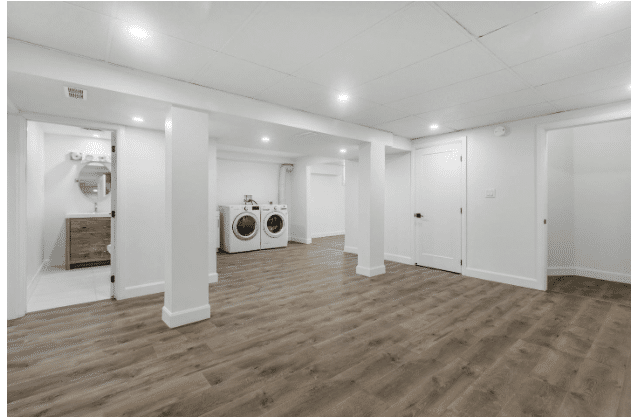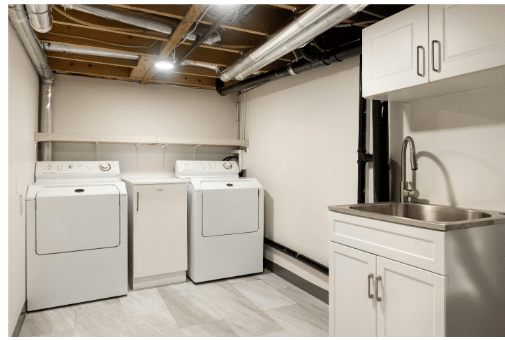Has your basement remained musty, with a foul smell even though it’s dry?
Odd odors can be annoying and worrisome when coming from beneath your house. You might have checked some obvious possibilities, like damp furniture or storage, but that odor has yet to disappear.
Therefore, it is usually hard to trace the source of such odors since various hidden culprits could be behind the foul smell. Moisture from underground soils, cracks in foundation walls, or leaks from drainage systems can all contribute to musty basement air.
Still, identifying possible causes is a critical step toward effectively fixing the problem of foul basement smell once and for all. Further narrowing down the root cause will let you target your corrective effort correctly.
1. Hidden Moisture Sources

One frequent cause of musty basement odors is hidden pockets of excess moisture that aren’t visible on the surface. To track these down, start by using a digital moisture meter to test the general humidity level in the space. Then, carefully examine wall cavities, utility rooms, and floor joist bay areas for signs of dampness.
It’s also a good idea to peel back any vinyl wallpaper or siding to check behind for signs of moisture intrusion. Look out for cracks in poured concrete walls or floors that could allow water to seep in unnoticed. Catching damp problem areas early is critical to preventing further damage or worsening smells.
If excess moisture is located, tackle it at its source with a dehumidifier, fans for air circulation, or moisture-controlling products to soak up water. Monitoring humidity levels will help determine when the problem is fully resolved. Early detection and treatment of hidden moisture sources is often very effective for odor removal.
Companies like Basement Waterproofing West Chester PA, can help identify and resolve moisture issues before odors arise. Their professional basement waterproofing services are designed to prevent humidity issues by installing drainage solutions and vapor barriers.
2. Poor Ventilation
When a basement lacks sufficient airflow circulation, trapped moisture cannot dissipate, developing evaporative odors. To address this issue:
- Check Ventilation Features: Ensure all existing ventilation systems in your space function correctly.
- Consider Additional Ventilation: If necessary, look into adding a vent fan to help control moisture levels.
Before Installing New Fans
- Inspect Existing Systems-Identify any existing ventilation systems and check that dampers, ductwork, flex pipes, and air filters are clear of obstructions.
- Check for Air Leaks- Carefully inspect the sealing around ductwork that penetrates basement walls for any air leaks that might be introducing moist indoor air where it doesn’t belong.
Optimizing Airflow
- Reduce Residual Moisture: With optimized airflow, residual moisture’s capacity to breed musty smells greatly diminishes.
- Open Windows: Weather permitting, open basement windows to boost ventilation and enhance airflow exchange, which is crucial for drying out odd odors.
3. Old Carpeting or Upholstery
If a home’s basement has had wall-to-wall carpeting or upholstered furniture that has since been removed, those prior items could still be culprits holding onto smells long past dry out. Their porous fabrics readily absorb odors that are very difficult to remove fully, even with cleaning.
Thorough laundering may revive less smelly items like curtains if proper drying time is given away from the basement. However, deep-set odors in carpets and upholstery typically require full replacement rather than storage to avoid lingering odors transferring elsewhere in the home. Discarding old materials is often best for banishing their likely contribution to lingering musty smells.

4. Previous Water Damage
Standing floodwaters or leaking plumbing pipes carrying ground moisture into a basement’s structure inevitably lead to odor-causing mold and mildew growth on invaded surfaces. Look out for tell-tale signs like water stains, warped floors/walls, or stained ceiling tiles, indicating past wetness issues.
Dried materials may emit a musty smell until entirely replaced due to mold hiding within porous components like drywall, fiberglass insulation, and original wood flooring or framing lumber that absorbed moisture. Here, scrubbing or surface treatments usually don’t eliminate odors at their source that are deeply embedded. Replacing damaged sections provides a fresh start.
5. Organic Materials in Walls
An exceedingly rare but potent cause arises when old homes contain animal hair, plant fibers, or other natural materials mixed directly into outdated wall construction products like plaster or mortar. Over decades, these organic additions slowly decay, releasing odors even in seemingly dry conditions.
If suspecting older walls contain such materials, close inspection may reveal tell-tale signs, or original building records could provide context. Removing these smelly components demands full re-plastering but resolves the stinky source very effectively. Proper identification is crucial in targeting less common odor problems.
6. Plumbing Pipe Leaks
Defective waste drains, vent stacks, and water supply pipes gradually introduce moisture, opening doors for musty odors to become established long-term. Use specialized pipe leak detectors run along subterranean lines or carefully monitor water bills for unexplained gradual rises as signs.
Inspect under-slab areas where plumbing runs closely for past water staining on the concrete. Isolated leaks may necessitate digging to access buried piping for repairs. Finding and addressing the leak cures its ability to feed odors over time in surrounding areas. This solution frequently resolves the root cause of basement smell issues.

7. Ductwork Issues
A characteristic rusty odor traceable directly to return air vents or ductwork indicates an active corrosion problem within the mechanical system. Check for signs of rust deposits, especially at duct connections and seams, which are more vulnerable to breakdown points.
Replace corroded galvanized steel duct sections with more durable materials and seal connections tightly to minimize dampness intrusion. Add air filters at supply/return transfers to catch debris before it reaches duct interiors, further preserving the system. Often, this targeted solution helps eliminate the specific furnace room stench at its source.
Being a thorough odor detective takes time but pays off in fully solving wet or musty basement smells closer to their roots. Periodic inspections also catch minor problems before they worsen. With systematic checks for moisture, ventilation, past water damage, and piping integrity, possible causes can be narrowed down. Applying focused remedies provides basement comfort and indoor air quality for years.

Final Thoughts
Many factors contribute to musty odors plaguing seemingly dry basements. Between hidden moisture retention, organic matter decay, past floods, and stealthy water leaks, such a space presents ample opportunities for smells to develop. With patience and diligent sleuthing, likely root causes can be uncovered via moisture checks, tracing sources of decay/wetness, and thoroughly investigating the home’s infrastructure history.
Confidently pinpointing odor origins allows corrective solutions like ventilation enhancement, moisture control, targeted material removal, and replacement to eliminate lingering issues at their very source. Homeowners who take the time for careful investigative work often see a big payoff in completely removing that stale basement stink for good through longer-term problem-solving.


